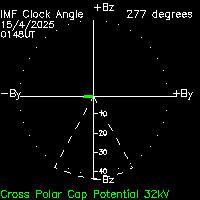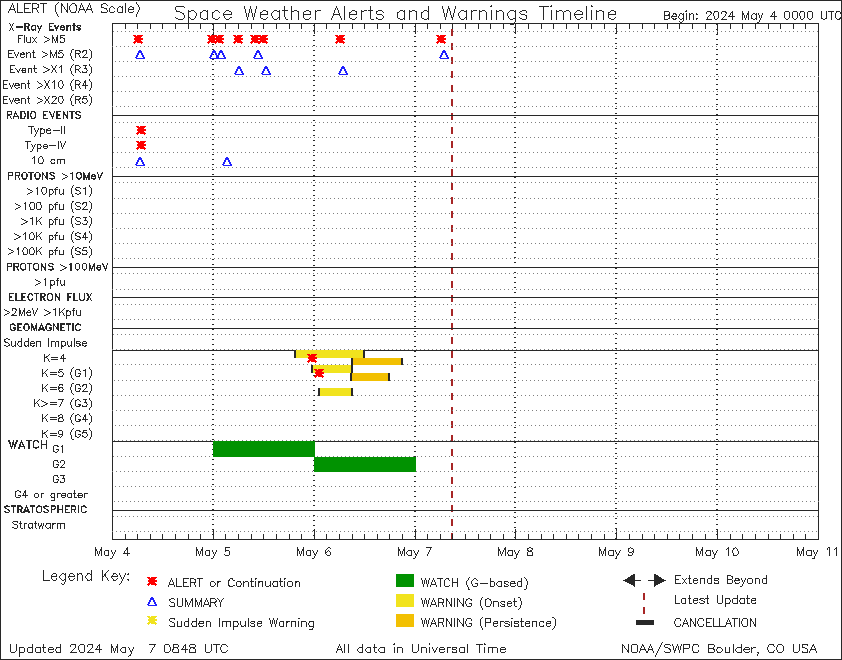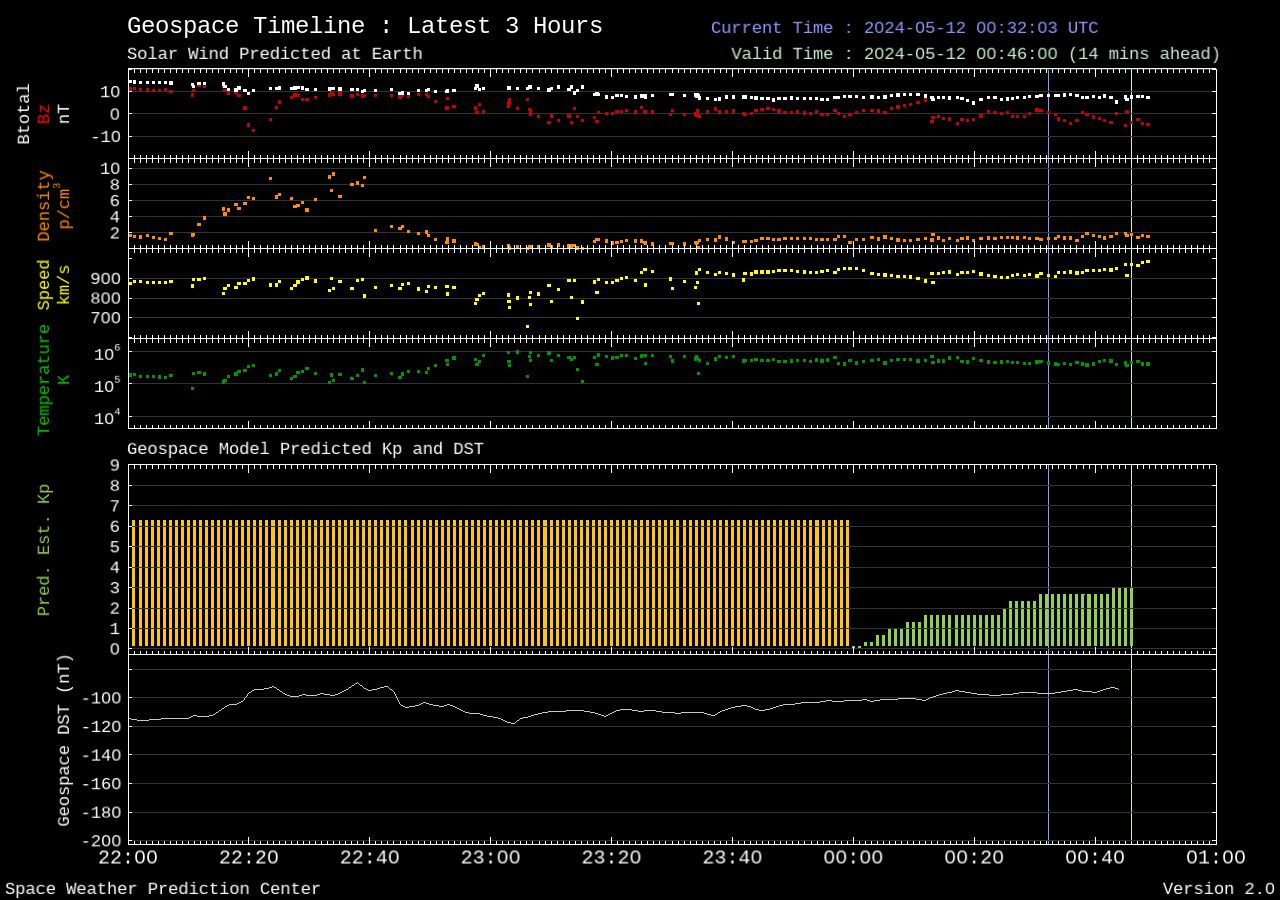
![[M↓]](../../images/markdown.transparent.png) Markdown, makefile
Markdown, makefile Coronal Holes Type IV Noise Now
Coronal Holes Type IV Noise Now Coronal Holes &
Coronal Holes &
 Days to Next Sector Boundary Crossing
Days to Next Sector Boundary Crossing IMF & Solar Wind
IMF & Solar Wind Interplanetary Magnetic Field Clock Angle
Interplanetary Magnetic Field Clock Angle Interplanetary Magnetic Field Polar Angle
Interplanetary Magnetic Field Polar Angle Interplanetary Magnetic Field Azimuth φ
Interplanetary Magnetic Field Azimuth φ Interplanetary Magnetic Field Magnitude
Interplanetary Magnetic Field Magnitude Solar Wind Model Coronal Holes, CMEs & Type IV Noise
Solar Wind Model Coronal Holes, CMEs & Type IV Noise Solar Wind Density
Solar Wind Density Solar Wind Speed
Solar Wind Speed Solar Wind Pressure
Solar Wind Pressure Induced Voltage Across Polar Cap
Induced Voltage Across Polar Cap Relativistic Electrons History & 3-Day Forecast
Relativistic Electrons History & 3-Day Forecast Solar Wind Electrons Cause Type IV Noise, PCA
Solar Wind Electrons Cause Type IV Noise, PCA Polar Cap Absorption by Solar Electrons & Protons
Polar Cap Absorption by Solar Electrons & Protons Aurora Caused by Geomagnetic Disturbances
Aurora Caused by Geomagnetic Disturbances Alert
Alert Kp Index 3h Prediction
Kp Index 3h Prediction Kp Index 7-Day Forecast
Kp Index 7-Day Forecast Kp Index 27-Day Forecast
Kp Index 27-Day Forecast Kp and the Magnetic Latitude
Kp and the Magnetic Latitude Current Geomagnetic Pole
Current Geomagnetic Pole HF Propagation Overview
HF Propagation OverviewOur Sun is not merely a source of electromagnetic radiation. An incessant slow flow of low-energy (1.5 to 10 keV) particles1 —protons, electrons and ions— coasts away along the Sun’s magnetic field (nominally 5 nT)2 into interplanetary space. This combination of the interplanetary magnetic field carrying solar particles is called the slow solar wind.
Holes in the Sun’s corona are a source of additional high-speed particle streams, constituting the fast solar wind. If a coronal hole (CH) is Earth-directed, these high-speed particles reach Earth in approximately five days. Coronal holes typically last between six and eight Sun rotations. This implies that, in little over 27 days time, the same coronal hole may be again pointing towards Earth.
Earth-orbiting satellites provide real-time proton flux readings. Solar protons with energies between 1 to 200 MeV are responsible for most of the ionisation of the D-layer3 and, consequently, for the ionospheric absorption of HF radio waves. Nonetheless, Earth’s geomagnetic field shields off most solar particles. Only at high latitudes around the geomagnetic poles, can solar particles easily enter Earth’s ionosphere. Earth’s nominal geomagnetic field strength has local variations. The maximum nominal field strength is 66 µT at the magnetic poles, and the local minimum is 24 µT.4
Occasionally, any type of active solar region, including flares, may produce a coronal mass ejection (CME). The energetic particles of an Earth directed-CME will reach Earth in between 19 hours and five days, depending on the speed of these particles. If the Earth-directed CME is particularly dense, the proton flux above the geomagnetic poles will increase dramatically, resulting in polar cap absorption (PCA). Its severity is expressed from S1 to S5 on NOAA’s (poorly named) solar radiation storm scale. HF and VHF (3–300 MHz) signals will be subject to absorption above the poles, whereas VLF and LF (3–300 kHz) radio waves will be reflected at lower altitudes than normal. Following the end of a PCA event, trans-polar radio paths may be disturbed for days, up to weeks.
The magnetic field of the fast solar wind can disturb Earth’s geomagnetic field. This is especially the case when the magnetic field of the solar wind opposes Earth’s magnetic field; i.e. the Bz component of the solar wind (perpendicular to the ecliptic plane) is negative (pointing upwards). —Remember: Despite a looming pole reversal, Earth’s geomagnetic north still corresponds to a south pole in Earth’s bar magnet dipole model!— A disturbed geomagnetic field results in auroral ovals that are larger, more intense and lower in magnetic latitude than under normal, quiet conditions. This is indicated by larger planetary Kp values. Severe geomagnetic storms occur when Kp > 4. Their severity is expressed from G1 to G5 on NOAA’s geomagnetic storm scale.

https://spacenews.com/are-small-satellites-the-solution-for-space-weather-monitoring/


